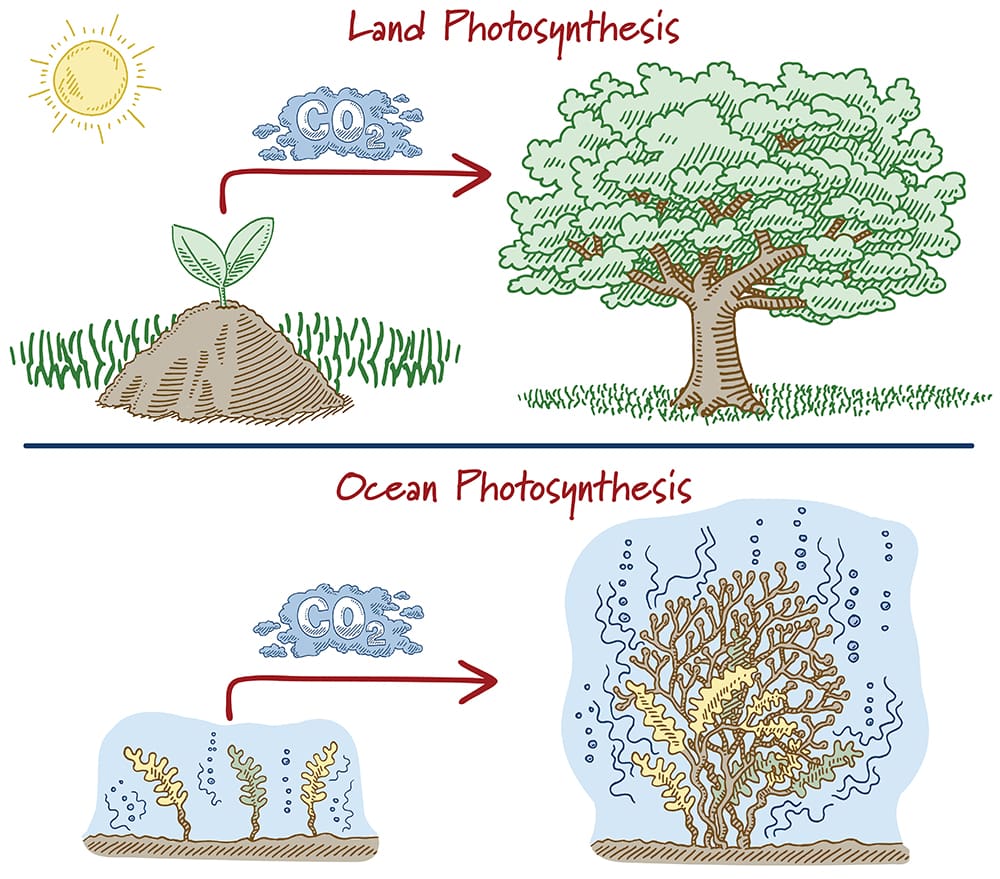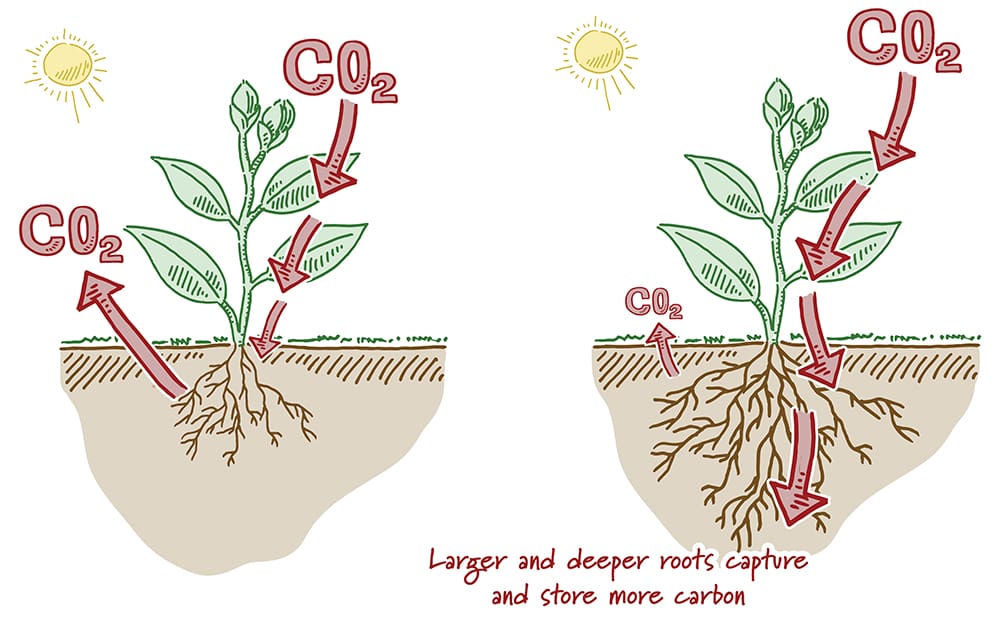Posted on January 25, 2023 by Jasmine Yu
There is a long history of research and political interest in hybrid CDR. For example, innovations that utilize biomass, or renewable material from plants and animals, were initially discussed at the start of international negotiations in the early 1900s.
A number of recent U.S. policies, including the Energy Act of 2020, Infrastructure Investment and Jobs Act and the CHIPS and Science Act of 2022, reduce the cost and seek to improve the efficiency of CDR while driving American ingenuity. The bipartisan CREST Act, which aims to expand CDR technologies, quantify their net impact, and establish an innovative pilot carbon dioxide purchasing program to accelerate market commercialization of high-quality innovations, was recently introduced in both the House and Senate.
Two specific approaches – land-based Biomass Carbon Removal and Storage (BiCRS) and ocean-based macroalgae cultivation – currently have significant carbon removal potential.

The idea of producing energy using biomass combined with carbon capture and sequestration is more than two decades old. 16 BECCS projects currently exist globally, and together capture a total of 1.89 million metric tons (MMT) of CO2 per year. Of these BECCS projects, one stands out from the rest: the U.S. Department of Energy’s (DOE) National Energy Technology Laboratory (NETL) Illinois Basin-Decatur Project, which is reported to capture and sequester between 0.52 to 1 MMT of CO2 annually from biofuel production by injecting CO2 7,000 feet below ground into the Mt. Simon Sandstone saline reservoir.
DOE’s National Renewable Energy Lab (NREL) forecasted the U.S. will need between seven to 14 gigawatts (GW) of installed BECCS capacity by 2035 to achieve an electricity system with net-zero CO2 emissions. These estimates assume the feedstock used is a woody biomass that requires minimal processing, with a total availability of 105 million dry tons per year. The most ideal feedstocks for BECCS should be low-cost and not compete for fertile agricultural land that can be used for growing food or feed. Recent reports like these, legislative action supporting BECCS, and the abundance of low-grade wood and wood industry residues all demonstrate that the U.S. is a promising market for BECCS.
BECCS is also becoming recognized by international companies – for example, the U.K.-based renewable energy company Drax is in the early stages of developing a BECCS project in California.
In 2021, the DOE Office of Scientific and Technical Information (OSTI) published a technical report that introduced a new term: biomass carbon removal and storage (BiCRS), which refers to a range of technologies that use biomass to remove CO2 from the atmosphere and store it underground or in long-lived products. The concept of BiCRS includes BECCS technologies, in addition to other up-and-coming technologies that emphasize biomass accumulation from carbon capture through photosynthesis. This more inclusive categorization further leverages the high carbon value of biomass.
BiCRS’ carbon removal potential is estimated to be between 2.5 and 5.0 gigatons (Gt) of CO2 per year, but only about 0.0025 Gt CO2 is currently sequestered from existing facilities. There has been recent interest in BiCRS technologies: Carba, a Minneapolis, MN, based start-up, was founded in 2021. Their innovation mimics and speeds up the formation of coal from trees using low temperatures. The resulting stable carbon product is then buried. Another BiCRS start-up – Arbor, based in Los Angeles, CA – has become a Shopify Sustainability Fund partner and plans to launch in 2023. Arbor is developing a low-cost, energy-efficient modular system to turn biomass waste into gas for storage.

The ocean is the largest natural carbon sink, so it’s no surprise that conversations on how to take advantage of its carbon uptake potential have been happening since the 1990s. Ocean CDR removal technologies change the ocean’s natural carbon cycle to reduce CO2 concentrations in the atmosphere. To increase the ocean’s carbon storage capacity, the natural ocean carbon cycle can be technologically enhanced by increasing the growth of aquatic plants or increasing ocean alkalinity concentrations.
Since the late 1980s, the field of marine photosynthesis and productivity has been extensively studied. Exploration of kelp and seaweed – or macroalgae – cultivation specifically for carbon removal began to gain traction as early as 2011. Approximately 170 million metric tons of CO2 are sequestered by macroalgae each year. To ensure that the carbon is stored permanently, macroalgae can be intentionally sunk into deep water. A kelp farming start-up, Running Tide, based in Portland, ME, is working on a technology that would send biodegradable carbon buoys seeded with kelp into the open ocean. After three months, kelp growth around the buoys will create significant weight, causing it to sink to the ocean floor.
Insulation is used throughout buildings to keep people warm and save on energy costs. When building insulation is made with both plant material (cellulose) and the roots of fungi (mycelium), it not only performs just as well as plastic foam insulation, but is also carbon negative.
In Alaska, the market for insulation can represent 30-50% of the cost of home building supplies. Fortunately, a research team at the University of Alaska Anchorage has been working on refining their carbon-negative insulation material, made with local biomass and fungi, for more than six years. The team’s innovative design is close to commercialization, and they hope to see wide-scale deployment of carbon-negative insulation within 10 years.

Land-based innovations don’t end at just planting more trees – the soil beneath these trees and on agricultural lands is also a massive carbon sink that holds up to 2,500 Gt of carbon in just the top three meters of soil – about 3.3 times the amount of carbon in the atmosphere (760 Gt).
Agriculture currently accounts for around 10-14% of global emissions, but there is great potential for the industry to sequester more CO2 than it emits. One method is by increasing the amount of carbon sequestered by the soil. This can be achieved by increasing the size of root systems, so they grow deeper and have greater surface area. Deeper root systems can reach deeper soil levels, where the carbon retention is greater, and roots with greater surface area can better release carbon into the soil for storage. Enhanced root systems also result in greater crop productivity and reduce the necessary quantity of agricultural inputs like water and fertilizer.
